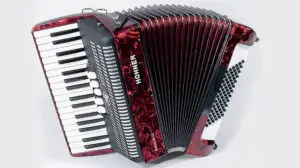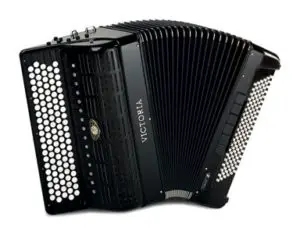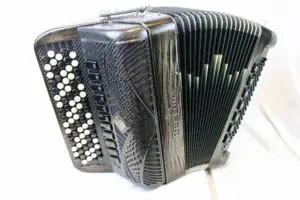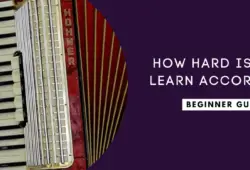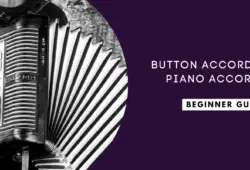Well, there are various types of accordions.
It can get overwhelming at first because there are a dozen of these accordions that may look the same to the untrained eye but they’re indeed different.
You have probably heard of the piano accordion. That’s the most common accordion type but there are many similar instruments that may be you have not had the chance to meet yet.
This article will help you understand the most important types of accordions out there and learn how you can differentiate between them.
Table of Contents
Accordion Types: The Most Common
What comes to your mind when you hear the term accordion? Music? Chords? This musical term was derived from the German word “akkord,” which translated to “concord of sounds” or simply “musical chords.”
Like most musical instruments, the accordion comes in various sizes and forms. And as already discussed in my previous article, “how hard it’s to learn accordion,” some of these instruments consist of piano keys, while others come with buttons like the button accordion.
Also, with the various manufacturers in today’s market, the accordions are made of different material quality, use different reeds, and the number of keys varies.
Because of this, you can distinguish the various sounds made by these instruments, no matter how similar they might appear.
To help you understand what I am talking about, here are the various type of accordion, in no specific order.
Some are more popular than others, but they play similar roles. Enjoy!
1) Piano Accordions
The piano accordion is the most popular accordion. And as its name suggests, this instrument proudly displays a piano-like keyboard.
Piano accordions contain a right-hand keyboard with a similar design and layout to that of a standard piano.
If you manage to purchase the full-size piano accordion, you will enjoy 41 treble piano keys and around three notes octaves.
However, there is a row of buttons on the left-hand side of this accordion to allow the bass accompaniment.
Also, the standard full-size piano accordion usually comes with 120 buttons. However, it isn’t uncommon to find an instrument with 140 buttons.
Another difference between the piano accordion and other types of instruments in this category lies in its base system. Most of the time, it can either be Stradella, free-bass, or even french3-3.
But most of the time, the bass system is Stradella.
Most beginner piano accordions come with 12 buttons. Such instruments also have a 2-octave keyboard on their right-hand side for comfortable playing.
Most full-size piano keyboards come with a range of low “F” to a high of “A.”
And because of all these fantastic features, the piano accordion is considered as one of the most flexible in the accordion family. It can be used to play any kind of music, which explains its popularity.
2) Button Accordions
Unlike the piano accordion that contains a keyboard on the melody side, the button accordion lives true to its name.
It comes with buttons on the treble side.
And like the piano accordion, the button accordion one of the most popular and significant accordion-type you will find in musical performances across the world.
The button accordion comes in various styles and configurations to meet the needs of multiple users. But even then, it’s true that these instruments only contain single note buttons on one part.
The other side usually contains both the chord and bass buttons.
3) Chromatic Accordion
The chromatic accordion’s main features include the presence of buttons on both the left-hand side (bass buttons) and the right-hand side (treble). And most of the time, the configuration is either the free-bass or the Stradella system.
Most interestingly, this accordion type shares a specific similarity with the Piano accordion: they both use the same type of bass configuration button.
And because of these features, the chromatic accordion presents a wide range of pitches to its users, the reason as to why it’s used in various performances.
For instance, the treble part of this instrument consists of a 3-5 configuration of button rows. And that’s not all. It also has either a C-Grif or the B-Grif, with a unique arrangement f notes on the keyboard.
Therefore, the C-system of this instrument focuses on playing the chords, while the B-system is suitable for the classical tunes.
Additionally, even though this instrument is flexible enough to accommodate various music styles, the outcome usually depends on how perfectly the reeds are fixed/tuned.
So, before you discard your instrument for not providing you with the versatility you require, check on the reeds.
They could be the problem, and you won’t have to “throw” the entire piece away. Sometimes, they only need a little fixing, and you will be enjoying numerous tunes.
The chromatic accordion is rampant in classical musical styles, Balkan and some Russian folk music.
These instruments might not be conventional in the US, by they are widespread across Europe.
4) Diatonic Accordion
You can’t speak of the chromatic accordion without mentioning the diatonic instrument.
These instruments are recognized mainly for their role in ethnic and folk music performances.
Mostly, the diatonic accordion comes with buttons, and they can comprise of one or many button rows.
The primary difference between the diatonic accordion and the chromatic is the pitch produced by the reeds. The diatonic instrument uses bisonoric reeds, which change tune whenever the bellows are pulled out or pushed in. This isn’t the case with the chromatic accordion.
Additionally, the diatonic instrument changes on the chords, and bass notes significantly depend on the bellows’ direction.
The instruments in this category are restricted to using specific keys when playing. Therefore, for example, if you’re using a three-row buttons instrument, you might get one with keys G, F, and C, or Eb, B, and the F keys.
But it’s acceptable if you use other keys.
As for the single row diatonic, you can still find one, but will majorly help you play Celtic, Norteno and Cajun types of music.
You can also use the diatonic instrument to play Zydeco tunes.
5) Concertina
The concertina is usually not classified as a “true” accordion. But its features speak otherwise and they point it out as a type of accordion. And that’s why I include it on this list today.
These types of instruments are smaller than the standard accordions, but they’re also hand-held.
Also, one more thing that differentiates this device is free-reed nature.
They make great companions for accordionist travelers, as they’re compact enough to fit in backpacks, and boots without much space.
This could be the reason to why most sailor players prefer it over the full-size accordions.
Like the chromatic, piano, and button accordions, these instruments have various types of systems. And the three major ones include the Anglo, English, Duet, and the German concertinas.
Therefore, you can liken the versatility that this instrument presents to users to that of the diatonic, chromatic, and piano accordions.
Globally, the concertinas are famously used in Ireland for the love of folk music on those sides and parts of Europe.
6) Digital Accordions
If you’re alive today, then it means you’re living in a digital world.
And that means technological advancements are the order of the day. Therefore, it isn’t surprising to learn that accordion manufacturers have advanced their productions to the microchip bandwagons.
If you haven’t seen a digital accordion, you will soon. These musical tools come with inbuilt electronics, with or without the free reeds.
But they still maintain the appearance of the traditional accordions, and those who have tried them say that they feel just the same.
The significant advantage these instruments have over other accordion types is that they’re highly versatile. They can comfortably play multiple music styles and use sound effects.
Check out this performance:
7) Unisonoric Accordions
Another thing that differentiates the accordions is their Unisonoric or bisonoric nature. And they typically refer to the manner the bellows produce various notes and sound as the air moves through the reeds.
Let’s discuss the Unisonoric accordions first.
In this case, the accordion produces a constant sound, no matter how the bellow moves. But, the sounds produced depend on the size of the instrument being used.
Because of this, the unisoronic accordions, as their name suggests, are used in performances where sound consistency is vital.
8 Bisonoric Accordions
These accordions produce two or more notes and pitches when the player presses the buttons, and the bellows move to any given direction.
The sounds produced also depends on the way the bellows are pulled out. For example, are the pulled down or pushed in?
Types of Hybrid Accordions
a) Schrammel Accordion
This is an excellent example of a hybrid accordion. It comes with a treble side, similar to that of the chromatic accordion, complete with a bass side.
The bass area of this accordion comprises of the 12-button keyboard, the diatonic and the bisonoric.
And because of all these features, it’s quite complex to learn, but once you do, you will enjoy the full performance.
b) British Chromatic Accordion
The British chromatic accordion is commonly used in Scotland. Its left-hand side uses the Stradella system, while the right-hand area is bisonoric.
And to cater to the elite performances, it has an upgrade popularly known as “Shand Morino.”
c) Russian Garmon
The presence of buttons characterizes this type of hybrid accordion. The Russian Garmon comes with two rows of buttons on its treble side.
The buttons row is used to play notes on the diatonic scale.
It also has at least two rows of buttons on its left-hand side. These buttons are used to play the primary chords and the present harmonic minor keys.
Although not all instruments come with additional right-hand keys, most of them do. And they are popularly referred to as the accidental notes. Also, some of the extra chords are used to play various related keys.
There is also a row of free bass buttons, which allow players to produce bass melodies.
As its name suggests, this accordion is most common in Russia, and its presence is rampant if Russian traditional music performances.
However, you can find it being used by the Georgian, Mari, Azeri, and Volga regions folk performers, among others.
And because it’s pretty flexible and can comfortably accommodate some modern tunes, the Russian Garmon is gaining popularity in the US and Europe.
d) Bayan
Like the Russian Garmon, the Bayan is a type of accordion that is popularly used in Russia and is categorized as one of the chromatic button accordions.
It’s believed to have been innovated in the 20th century. The history of this accordion’s name takes us back to the 11th century’s Minstrel, Boyan.
One of the distinctive nature of this musical instrument is the wider and massively rectangular reeds it proudly displays. These reeds are hard to ignore at first glance and are nothing like those of the western button accordions.
The Boyan has its melody-side keyboard fixed to the center of its body. And even with their massive nature, this instrument’s reeds aren’t tuned using the tremolo.
The instruments come in varieties and are commonly associated with the release of more vibrant bass sounds than their western counterparts.
e) Bandoneon
This instrument is classified as a type of concertina. However, the significant difference between the standard concertina and this musical device is their size. The bandoneon is larger and not smaller or compact, like the concertina.
And because of this, performers have to support it using their knees whenever they perform.
Additionally, the bandoneon is commonly used in religious performances and even in some gigs involving music from the 19th century.
So, it isn’t uncommon to see these instruments in tango music events. Tango music performers and producers prefer it because of its distinctive sounds, which are the signature tunes of these music styles.
Check out Astor Piazzolla’s famous Bandoneon performance below:
f) Trikitixa
The Trikitixa accordion is also referred to as the trikiti. And it’s a two-row diatonic accordion, which is commonly used among the Basque performers.
This musical instrument contains a diatonic, bisonoric treble, and the unisoronic bass, with 12-buttons row.
Fun fact: the Trikitixa, is a highly recognized national instrument in the ethnic group of Basque.
Diatonic vs. Chromatic Accordion
Both the Diatonic and the chromatic accordions are the main styles of the accordion instrument. And they both have button keys.
What distinguishes the diatonic accordion from the chromatic is that it comes with either 3, 2, or even 1 row of buttons. Each row in this instrument is tuned to a given key, which has notes within that scale.
Therefore, when playing the diatonic, you will realize that each note is meant to play a different note, depending on the state of the bellows.
For example, are they being pushed or pulled?
Additionally, the diatonic instrument consists of 2-4 left-handed buttons. These buttons provide bass notes and are mostly chord tuned to a specific key on the melody buttons.
On the other hand, the chromatic accordions consist of a 3-5 button row on the melody part of the instrument. And unlike their chromatic counterpart, this instrument’s buttons are tuned a specific note, without considering the state of the bellows.
This explains why chromatic accordion players can easily play in any key. But even so, they have to ensure they have at least a single button for each note, no matter how sharp, natural, or flat it’s.
Also, with the chromatic accordion, you will realize that it contains many chords on the left side.
The chromatic accordion’s primary downsides lie in its unfamiliar keyboard layout, which makes it more complicated for learners to master.
The chromatic accordions are also more expensive than their diatonic counterparts, and they have limited tutoring books.
FAQs About The Types of Accordion
What Is A Small Accordion Called?
The smaller version of the accordion is commonly referred to as the concertina. It’s a free-reed instrument and comes with multiple bellows. The bellows can comfortably expand and contract.
The concertina also has piano keys on both ends, strategically placed on the instrument’s front side.
What Do the Three Main Types of Accordion Music Have in Common?
The diatonic, chromatic, and piano accordions are the three primary accordions.
And while the use of buttons characterizes both the diatonic and the chromatic types as keys, the keyboard instruments, also called piano accordions, feature piano-like keyboard keys.
Therefore, as you can see, they all have keys that play the same role, no matter the difference.
Which Accordion Is Easiest to Play?
According to reviews going around on the internet, the button accordion is the easiest to play. This is because its buttons are small, and the instrument uses fewer notes than other variations of accordion, such as the piano accordion.
Conclusion
The current music scene comprises of various accordions. Some are easy to play, while some aren’t.
So, before you invest in one, it’s best to go through all the available varieties (such as those mentioned above), examine the features and choose to match your needs.
Remember, if you choose the correct instrument, playing won’t be difficult. It’s a matter of prioritizing your requirements to achieve your goals.


